Abstract
The coexistence of bacteria in natural environments can often be explained in terms of competition for a growth-limiting substrate(s), and the outcome of such competition depends upon relevant growth parameters such as substrate affinity and yield. Dental plaque bacteria are frequently carbon and energy limited. Growth parameters for seven oral Streptococcus species and one Actinomyces viscosus strain were estimated under glucose-limited conditions in continuous culture. In all strains, mixed-acid fermentation occurred at low growth rates, while amounts of lactate increased at higher growth rates. Two important growth parameters, mumax and Y glucose, were very similar in the two serotype c Streptococcus mutans strains (T8 and Ingbritt), one of the serotype d/g Streptococcus mutans strains (OMZ65), and the two Streptococcus milleri strains (699B3 and B448). Two other serotype d/g S. mutans strains (KIR and B13) were divergent from this group and had lower mumax values and a lower Y glucose. The maintenance energy coefficients were lower in the S. mutans serotype c strains, and the highest values were observed in the S. milleri strains. While A. viscosus had a lower mumax, its lower maintenance rate and significantly higher yield indicate that it deals much more efficiently with glucose than do the streptococci. The most striking feature of amino acid utilization was that arginine was completely consumed by S. milleri strains; similarly, A. viscosus used up all available asparagine as did one of the S. milleri strains at faster growth rates. It is suggested that the ability of strains of S. milleri and S. sanguis to utilize arginine in addition to carbohydrate as a source of energy may explain why such organisms increase in proportion in the plaque of subjects consuming diets almost devoid of fermentable carbohydrate.
Full text
PDF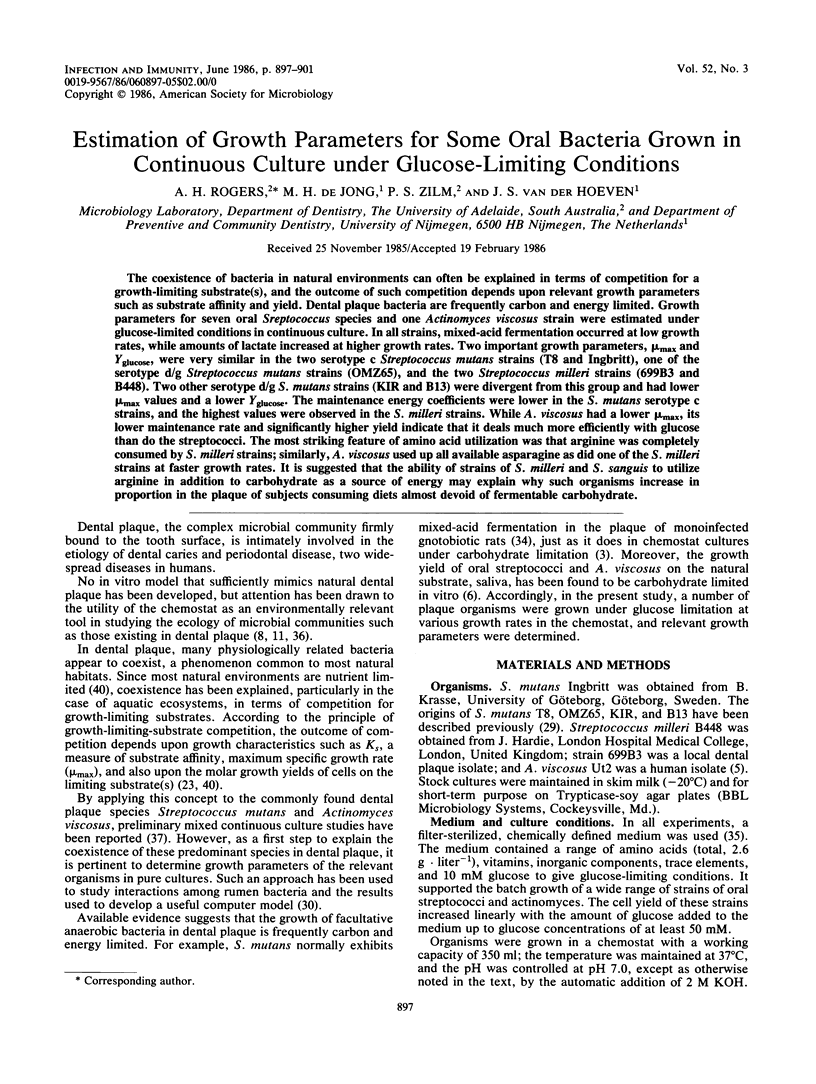
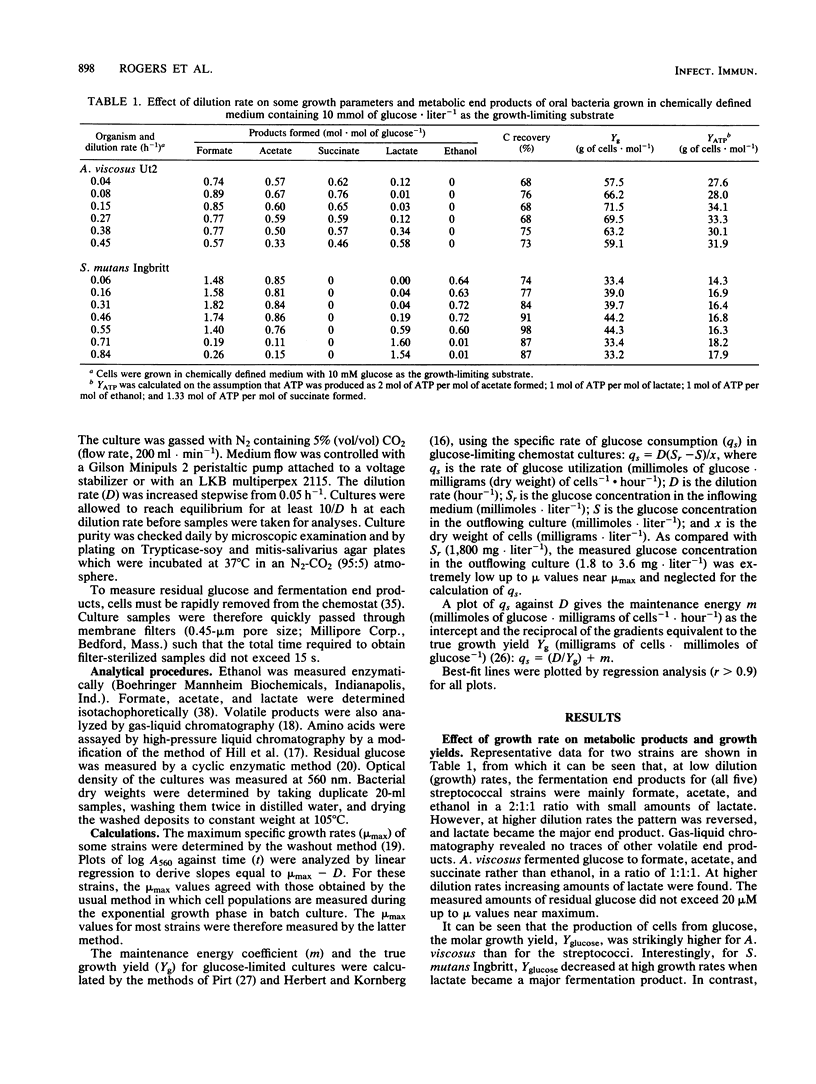
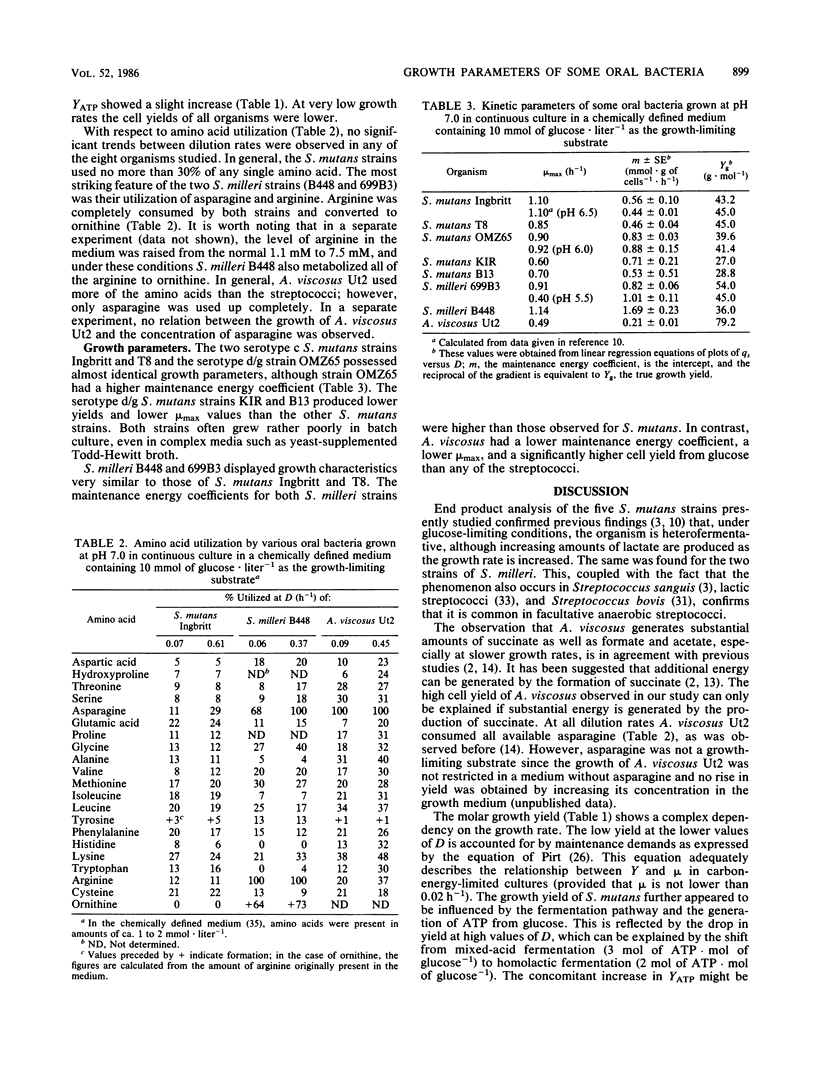
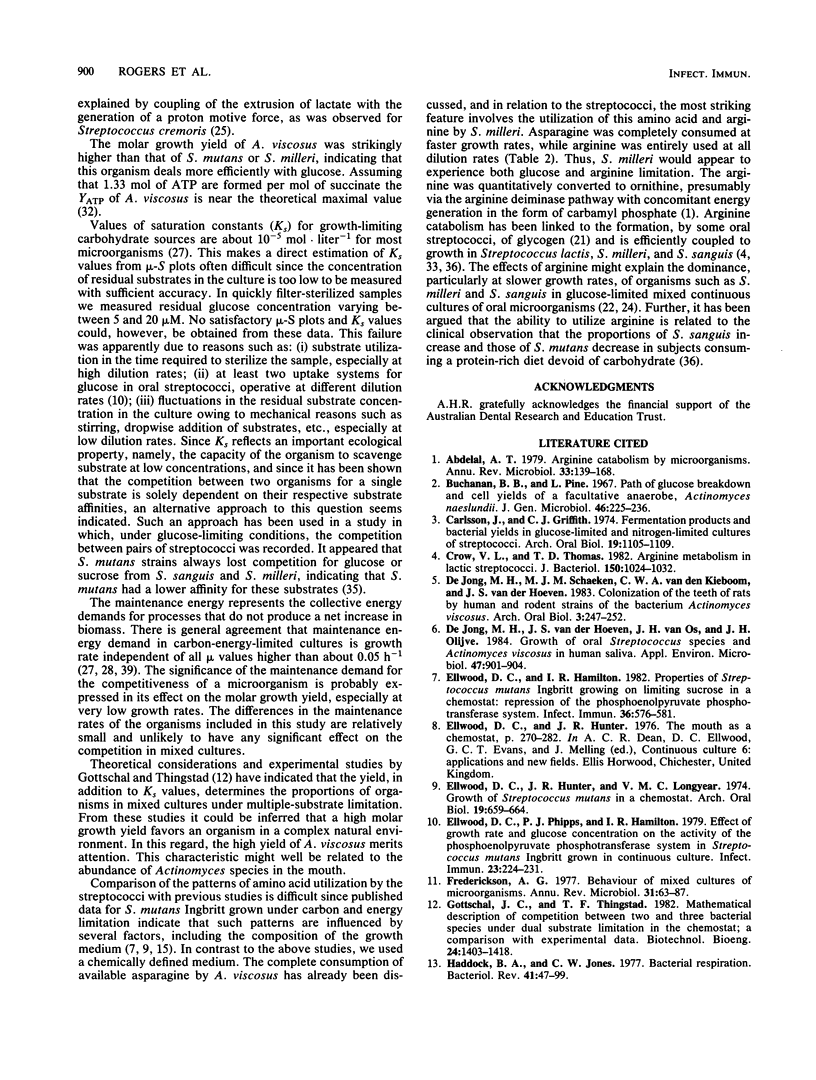
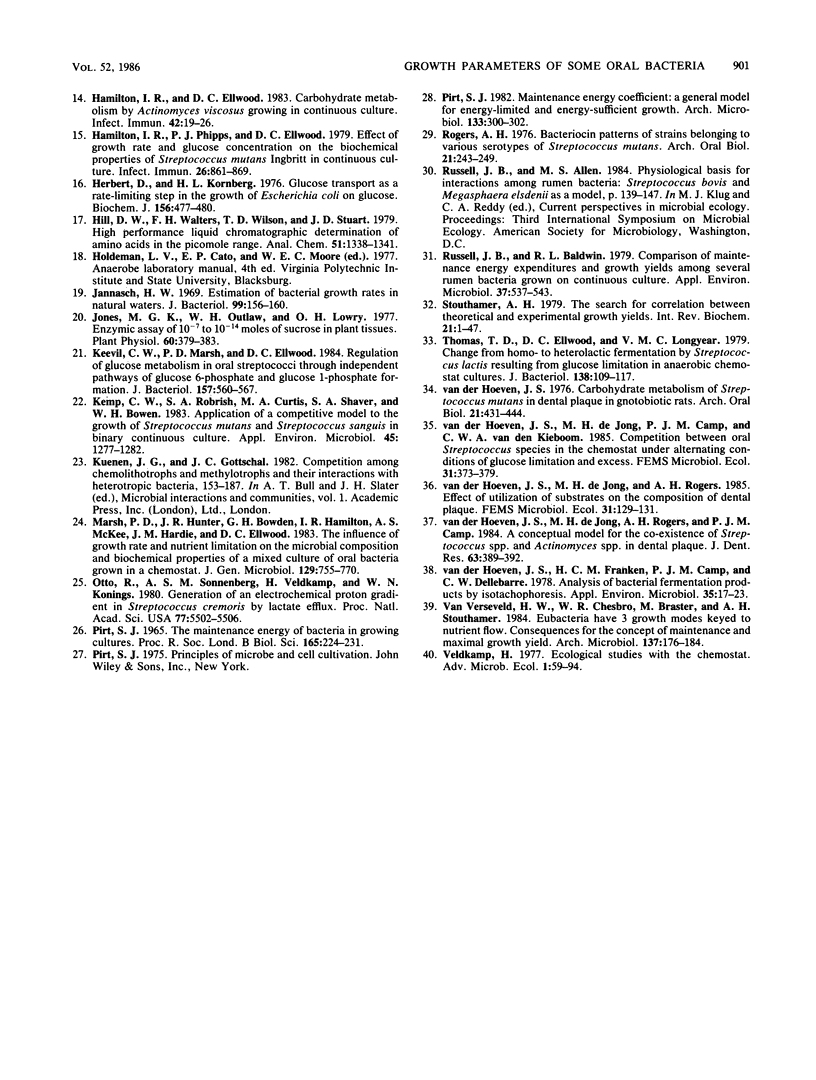
Selected References
These references are in PubMed. This may not be the complete list of references from this article.
- Abdelal A. T. Arginine catabolism by microorganisms. Annu Rev Microbiol. 1979;33:139–168. doi: 10.1146/annurev.mi.33.100179.001035. [DOI] [PubMed] [Google Scholar]
- Buchanan B. B., Pine L. Path of glucose breakdown and cell yields of a facultative anaerobe, Actinomyces naeslundii. J Gen Microbiol. 1967 Feb;46(2):225–236. doi: 10.1099/00221287-46-2-225. [DOI] [PubMed] [Google Scholar]
- Carlsson J., Griffith C. J. Fermentation products and bacterial yields in glucose-limited and nitrogen-limited cultures of streptococci. Arch Oral Biol. 1974 Dec;19(12):1105–1109. doi: 10.1016/0003-9969(74)90238-6. [DOI] [PubMed] [Google Scholar]
- Crow V. L., Thomas T. D. Arginine metabolism in lactic streptococci. J Bacteriol. 1982 Jun;150(3):1024–1032. doi: 10.1128/jb.150.3.1024-1032.1982. [DOI] [PMC free article] [PubMed] [Google Scholar]
- Ellwood D. C., Hamilton I. R. Properties of Streptococcus mutans Ingbritt growing on limiting sucrose in a chemostat: repression of the phosphoenolpyruvate phosphotransferase transport system. Infect Immun. 1982 May;36(2):576–581. doi: 10.1128/iai.36.2.576-581.1982. [DOI] [PMC free article] [PubMed] [Google Scholar]
- Ellwood D. C., Hunter J. R., Longyear V. M. Growth of Streptococcus mutans in a chemostat. Arch Oral Biol. 1974 Aug;19(8):659–664. doi: 10.1016/0003-9969(74)90134-4. [DOI] [PubMed] [Google Scholar]
- Ellwood D. C., Phipps P. J., Hamilton I. R. Effect of growth rate and glucose concentration on the activity of the phosphoenolpyruvate phosphotransferase system in Streptococcus mutans Ingbritt grown in continuous culture. Infect Immun. 1979 Feb;23(2):224–231. doi: 10.1128/iai.23.2.224-231.1979. [DOI] [PMC free article] [PubMed] [Google Scholar]
- Fredrickson A. G. Behavior of mixed cultures of microorganisms. Annu Rev Microbiol. 1977;31:63–87. doi: 10.1146/annurev.mi.31.100177.000431. [DOI] [PubMed] [Google Scholar]
- Haddock B. A., Jones C. W. Bacterial respiration. Bacteriol Rev. 1977 Mar;41(1):47–99. doi: 10.1128/br.41.1.47-99.1977. [DOI] [PMC free article] [PubMed] [Google Scholar]
- Hamilton I. R., Ellwood D. C. Carbohydrate metabolism by Actinomyces viscosus growing in continuous culture. Infect Immun. 1983 Oct;42(1):19–26. doi: 10.1128/iai.42.1.19-26.1983. [DOI] [PMC free article] [PubMed] [Google Scholar]
- Hamilton I. R., Phipps P. J., Ellwood D. C. Effect of growth rate and glucose concentration on the biochemical properties of Streptococcus mutans Ingbritt in continuous culture. Infect Immun. 1979 Dec;26(3):861–869. doi: 10.1128/iai.26.3.861-869.1979. [DOI] [PMC free article] [PubMed] [Google Scholar]
- Herbert D., Kornberg H. L. Glucose transport as rate-limiting step in the growth of Escherichia coli on glucose. Biochem J. 1976 May 15;156(2):477–480. doi: 10.1042/bj1560477. [DOI] [PMC free article] [PubMed] [Google Scholar]
- Hill D. W., Walters F. H., Wilson T. D., Stuart J. D. High performance liquid chromatographic determination of amino acids in the picomole range. Anal Chem. 1979 Jul;51(8):1338–1341. doi: 10.1021/ac50044a055. [DOI] [PubMed] [Google Scholar]
- Jannasch H. W. Estimations of bacterial growth rates in natural waters. J Bacteriol. 1969 Jul;99(1):156–160. doi: 10.1128/jb.99.1.156-160.1969. [DOI] [PMC free article] [PubMed] [Google Scholar]
- Jones M. G., Outlaw W. H., Lowry O. H. Enzymic assay of 10 to 10 moles of sucrose in plant tissues. Plant Physiol. 1977 Sep;60(3):379–383. doi: 10.1104/pp.60.3.379. [DOI] [PMC free article] [PubMed] [Google Scholar]
- Keevil C. W., Marsh P. D., Ellwood D. C. Regulation of glucose metabolism in oral streptococci through independent pathways of glucose 6-phosphate and glucose 1-phosphate formation. J Bacteriol. 1984 Feb;157(2):560–567. doi: 10.1128/jb.157.2.560-567.1984. [DOI] [PMC free article] [PubMed] [Google Scholar]
- Kemp C. W., Robrish S. A., Curtis M. A., Sharer S. A., Bowen W. H. Application of a competition model to the growth of Streptococcus mutans and Streptococcus sanguis in binary continuous culture. Appl Environ Microbiol. 1983 Apr;45(4):1277–1282. doi: 10.1128/aem.45.4.1277-1282.1983. [DOI] [PMC free article] [PubMed] [Google Scholar]
- Marsh P. D., Hunter J. R., Bowden G. H., Hamilton I. R., McKee A. S., Hardie J. M., Ellwood D. C. The influence of growth rate and nutrient limitation on the microbial composition and biochemical properties of a mixed culture of oral bacteria grown in a chemostat. J Gen Microbiol. 1983 Mar;129(3):755–770. doi: 10.1099/00221287-129-3-755. [DOI] [PubMed] [Google Scholar]
- Otto R., Sonnenberg A. S., Veldkamp H., Konings W. N. Generation of an electrochemical proton gradient in Streptococcus cremoris by lactate efflux. Proc Natl Acad Sci U S A. 1980 Sep;77(9):5502–5506. doi: 10.1073/pnas.77.9.5502. [DOI] [PMC free article] [PubMed] [Google Scholar]
- Pirt S. J. Maintenance energy: a general model for energy-limited and energy-sufficient growth. Arch Microbiol. 1982 Dec 3;133(4):300–302. doi: 10.1007/BF00521294. [DOI] [PubMed] [Google Scholar]
- Pirt S. J. The maintenance energy of bacteria in growing cultures. Proc R Soc Lond B Biol Sci. 1965 Oct 12;163(991):224–231. doi: 10.1098/rspb.1965.0069. [DOI] [PubMed] [Google Scholar]
- Rogers A. H. Bacteriocin patterns of strains belonging to various serotypes of Streptococcus mutans. Arch Oral Biol. 1976;21(4):243–249. doi: 10.1016/0003-9969(76)90042-x. [DOI] [PubMed] [Google Scholar]
- Russell J. B., Baldwin R. L. Comparison of maintenance energy expenditures and growth yields among several rumen bacteria grown on continuous culture. Appl Environ Microbiol. 1979 Mar;37(3):537–543. doi: 10.1128/aem.37.3.537-543.1979. [DOI] [PMC free article] [PubMed] [Google Scholar]
- Thomas T. D., Ellwood D. C., Longyear V. M. Change from homo- to heterolactic fermentation by Streptococcus lactis resulting from glucose limitation in anaerobic chemostat cultures. J Bacteriol. 1979 Apr;138(1):109–117. doi: 10.1128/jb.138.1.109-117.1979. [DOI] [PMC free article] [PubMed] [Google Scholar]
- de Jong M. H., Schaeken M. J., van den Kieboom C. W., van der Hoeven J. S. Colonization of the teeth of rats by human and rodent oral strains of the bacterium Actinomyces viscosus. Arch Oral Biol. 1983;28(3):247–252. doi: 10.1016/0003-9969(83)90154-1. [DOI] [PubMed] [Google Scholar]
- de Jong M. H., van der Hoeven J. S., van OS J. H., Olijve J. H. Growth of oral Streptococcus species and Actinomyces viscosus in human saliva. Appl Environ Microbiol. 1984 May;47(5):901–904. doi: 10.1128/aem.47.5.901-904.1984. [DOI] [PMC free article] [PubMed] [Google Scholar]
- van Verseveld H. W., Chesbro W. R., Braster M., Stouthamer A. H. Eubacteria have 3 growth modes keyed to nutrient flow. Consequences for the concept of maintenance and maximal growth yield. Arch Microbiol. 1984 Feb;137(2):176–184. doi: 10.1007/BF00414463. [DOI] [PubMed] [Google Scholar]
- van der Hoeven J. S. Carbohydrate metabolism of Streptococcus mutans in dental plaque in gnotobiotic rats. Arch Oral Biol. 1976;21(7):431–433. doi: 10.1016/0003-9969(76)90007-8. [DOI] [PubMed] [Google Scholar]
- van der Hoeven J. S., Franken H. C., Camp P. J., Dellebarre C. W. Analysis of bacterial fermentation products by isotachophoresis. Appl Environ Microbiol. 1978 Jan;35(1):17–23. doi: 10.1128/aem.35.1.17-23.1978. [DOI] [PMC free article] [PubMed] [Google Scholar]
- van der Hoeven J. S., de Jong M. H., Rogers A. H., Camp P. J. A conceptual model for the co-existence of Streptococcus spp. and Actinomyces spp. in dental plaque. J Dent Res. 1984 Mar;63(3):389–392. doi: 10.1177/00220345840630030601. [DOI] [PubMed] [Google Scholar]


